Sommigen schitteren op het podium, maar verbleken in de waarheid.
Some shine on stage, but fade in truth.
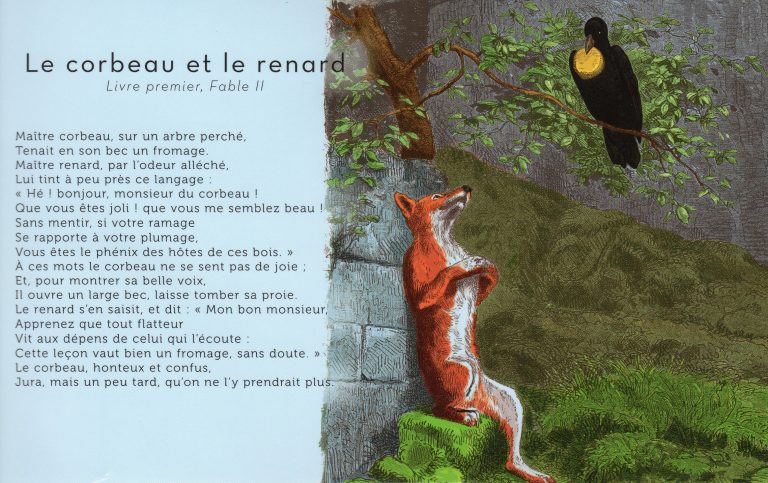
Page Description
Discover Jean de La Fontaine’s classic fable ‘The Crow and the Fox,’ a timeless tale about flattery and cunning, with a valuable lesson on pride and deception.
The Crow and the Fox: A Timeless Lesson in Flattery and Deceit
Jean de La Fontaine’s fable, The Crow and the Fox, is a masterful tale that distills human behavior into a simple yet profound story. Through the clever words of the fox and the vanity of the crow, La Fontaine captures the dangers of falling prey to flattery and the cunning nature of those who seek to manipulate. This timeless fable continues to resonate, offering a mirror to our own vulnerabilities and a reminder to look beyond the surface of sweet words.
De Raaf en de Vos: Een Tijdloze Les in Vleierij en Bedrog
Jean de La Fontaine’s fabel, De Raaf en de Vos, is een meesterlijk verhaal dat menselijk gedrag terugbrengt tot een eenvoudige maar diepgaande vertelling. Door de slimme woorden van de vos en de ijdelheid van de raaf legt La Fontaine de gevaren bloot van het bezwijken voor vleierij en de sluwheid van degenen die proberen te manipuleren. Deze tijdloze fabel blijft aanspreken, biedt ons een spiegel van onze eigen kwetsbaarheden en herinnert ons eraan verder te kijken dan de zoete woorden aan de oppervlakte.
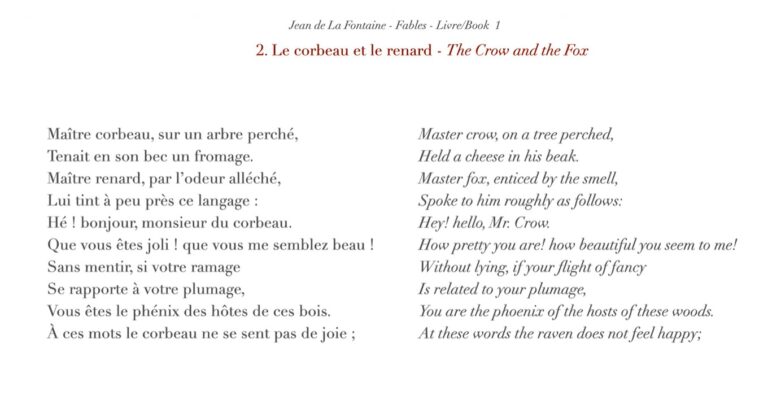
“The Crow and the Fox” by Jean de La Fontaine is a famous fable that imparts a moral lesson through the interaction between two animals. Here are the key points of the story:
Introduction of Characters:
- A crow is perched on a tree branch, holding a piece of cheese in its beak.
- A fox, passing by, notices the crow with the cheese and devises a plan to get it.
Flattery by the Fox:
- The fox praises the crow, complimenting its appearance and voice, despite not having heard it sing.
- The crow, flattered by the fox’s words, is eager to prove its beautiful singing voice.
The Crow’s Mistake:
- In an attempt to show off its singing, the crow opens its beak to caw, dropping the cheese.
- The fox quickly grabs the cheese and eats it.
The Fox’s Lesson:
- After securing the cheese, the fox tells the crow that flattery should not deceive them.
- The moral is revealed: “Never trust a flatterer.”
Moral Lesson:
- The fable teaches that vanity and gullibility can lead to one’s downfall.
- It warns against being swayed by flattery and emphasizes the importance of discernment and self-awareness.
La Fontaine’s fable uses simple yet engaging storytelling to convey a timeless moral about the dangers of succumbing to flattery and the importance of critical thinking.
1 Le Corbeau et le Renard – les Fables de La Fontaine en dessin animé – Hellokids.com
Abonne toi à la chaîne Hellokids.com ici: http://bit.ly/1HmqTFc Vidéo de Le Corbeau et le Renard – les Fables de La Fontaine en dessin animé
2 Le Corbeau et le Renard | Fable de La Fontaine | dessin animé en français avec les P’tits z’Amis
De vos en de kraai
Meneer de kraai troonde hoog op z’n stek
Met in zijn snavel een stuk kaas.
Mijnheer de vos rook daar spek voor zijn bek
en zei likkebaarden tot die dwaas:
“Ik groet u beste meester kraai.
Wat bent u wondermooi! zo fabelachtig fraai!
Ik meen het als ook uw kreet
even mooi blijkt als uw verenkleed,
dan bent u wis en waar de feniks van het woud.
De kraai zit van ‘t gepaaid te glimmen als puur goud
En op zoetgevooisd te kwelen,
zet hij een grote bek, maar laat zich zo bestelen.
De vos is er als de kippen bij: “Beste vriend,
vleiers worden goed bediend
ten koste van wie die gefleem behaagt;
weg is je kaas: ik hoop dat nu je lesje daagt.”
Beduusd schaamde de kraai zich zeer
en zwoer een late eed: dit lukt geen tweede keer!
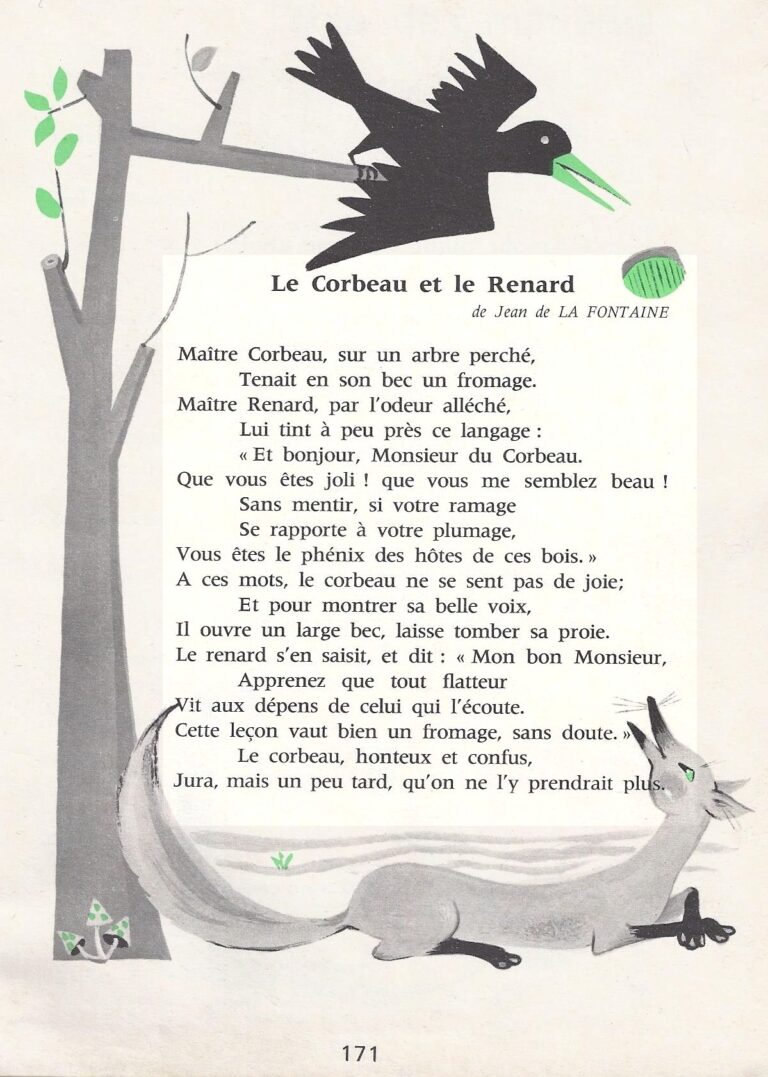
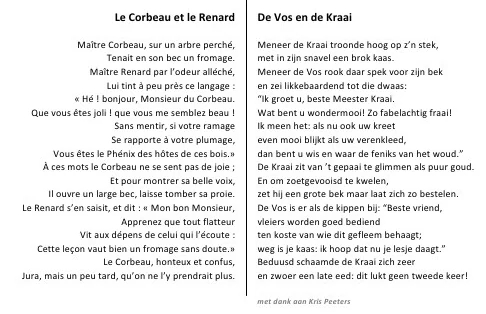
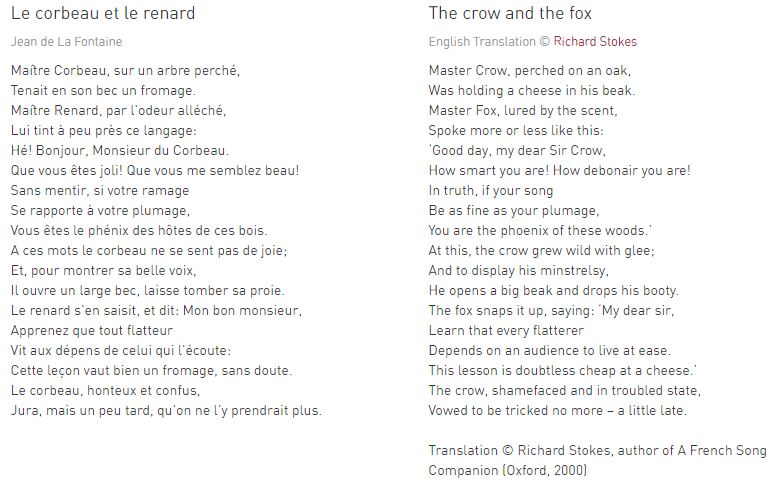
De vos en de kraai
Meneer de kraai troonde hoog op z’n stek
Met in zijn snavel een stuk kaas.
Mijnheer de vos rook daar spek voor zijn bek
en zei likkebaarden tot die dwaas:
“Ik groet u beste meester kraai.
Wat bent u wondermooi! zo fabelachtig fraai!
Ik meen het als ook uw kreet
even mooi blijkt als uw verenkleed,
dan bent u wis en waar de feniks van het woud.
De kraai zit van ‘t gepaaid te glimmen als puur goud
En op zoetgevooisd te kwelen,
zet hij een grote bek, maar laat zich zo bestelen.
De vos is er als de kippen bij: “Beste vriend,
vleiers worden goed bediend
ten koste van wie die gefleem behaagt;
weg is je kaas: ik hoop dat nu je lesje daagt.”
Beduusd schaamde de kraai zich zeer
en zwoer een late eed: dit lukt geen tweede keer!
Le Corbeau et Le Renard
Maître Corbeau, sur un arbre perché,
Tenait en son bec un fromage.
Maître Renard, par l’odeur alléché,
Lui tint à peu près ce langage :
«Hé! bonjour, Monsieur du Corbeau.
Que vous êtes joli! que vous me semblez beau!
Sans mentir, si votre ramage
Se rapporte à votre plumage,
Vous êtes le Phénix des hôtes de ces bois.»
A ces mots le Corbeau ne se sent pas de joie;
Et pour montrer sa belle voix,
Il ouvre un large bec, laisse tomber sa proie.
Le Renard s’en saisit, et dit : «Mon bon Monsieur,
Apprenez que tout flatteur
Vit aux dépens de celui qui l’écoute:
Cette leçon vaut bien un fromage, sans doute.»
Le Corbeau, honteux et confus,
Jura, mais un peu tard, qu’on ne l’y prendrait plus.
2 About the Author
Jean de La Fontaine (1621–1695) was one of France’s most celebrated poets and fabulists. Best known for his fables, La Fontaine used animals and allegory to reveal deep truths about human nature, power, and morality. Though written in the 17th century, his stories remain strikingly relevant today — exposing the vanity, deceit, and blind ambition that still shape our institutions and societies.
Jean de La Fontaine (1621–1695) was een van de meest gevierde dichters en fabelschrijvers van Frankrijk. Zijn fabels, waarin dieren en allegorie centraal staan, onthullen diepe waarheden over de menselijke aard, macht en moraal. Hoewel ze in de 17e eeuw zijn geschreven, zijn zijn verhalen nog steeds opvallend actueel — ze leggen de ijdelheid, misleiding en blinde ambitie bloot die ook vandaag onze instellingen en samenlevingen beïnvloeden.
3 From Foxes to Fake Lemonade: Gullibility Knows No Age
2 JFL Hidden Camera Pranks & Gags Fresh Pee Lemonade
Even the simplest smile can be deceiving.
In this hidden camera prank, cheerful kids offer passersby a glass of lemonade — with a secret twist. Like the crow charmed by the fox’s words, the victims fall for the surface charm… until it’s too late. A light-hearted reminder: appearances, and offers, can be misleading.
Zelfs de eenvoudigste glimlach kan misleidend zijn
In deze verborgen cameragrap bieden vrolijke kinderen voorbijgangers een glaasje limonade aan — met een geheime twist. Net als de raaf die bezwijkt voor de vleierij van de vos, trappen de slachtoffers in de charme… tot het te laat is. Een luchtige herinnering: schijn en aanbod kunnen bedrieglijk zijn.
4 When Vanity Takes the Stage: A Modern Fable in Two Clips
3 Keeping Up Appearances – Please Mind Your Head – S04 E06 Part 04
Hyacinth and Richard spend time in their very small apartment in the countryside. Hyacinth invites Elizabeth and Emmet for afternoon cucumber sandwiches, but bump into them on their way there and Hyacinth tries to give the impression that she can ride a horse. Later Emmet’s head gets stuck in the ceiling after Elizabeth spills her ice-cold lemonade on him, as Hyacinth’s other invited guests arrive.
4 Keeping Up Appearances – Please Mind Your Head – S04 E06 Part 05
In these two unforgettable scenes, Hyacinth is at the peak of her delusional self-confidence. She invites guests to a cramped countryside apartment, insists it’s part of their “weekend property,” and attempts to appear aristocratic — even pretending she can ride a horse. What follows is a perfectly timed collapse of social pretence, involving spilled lemonade and a guest with his head stuck in the ceiling. This is Hyacinth at her top-class best: desperately clinging to appearances while everything around her falls apart.
In deze twee onvergetelijke scènes is Hyacinth op haar absolute hoogtepunt van zelfbedrog. Ze nodigt gasten uit in een krappe plattelandsflat, noemt het trots hun “weekendverblijf” en doet alsof ze van adel is — zelfs haar vermogen om paard te rijden wordt opgevoerd. Wat volgt is een perfecte ineenstorting van de sociale schijnvertoning, met gemorste limonade en een gast wiens hoofd vast komt te zitten in het plafond. Dit is Hyacinth op haar best: krampachtig vasthoudend aan schone schijn terwijl alles om haar heen instort.
5 A Lesson in Humility
Some speak with conviction, but live a lie.
The Crow and the Fox is more than a tale about flattery. It is a mirror held up to those who crave admiration more than truth. The crow loses his prize not because of the fox’s cunning alone—but because he needed to believe the lie that made him feel important.
In real life, this pattern repeats. There are those who preach wisdom, wear the mask of authority, and bask in applause—while knowing their words are hollow. Diederik Stapel, hailed as a brilliant scientist, built a career on fiction. He was not merely wrong—he was a deliberate deceiver.
Humility is not modesty in speech. It is truth in action. And without it, even the loudest voice becomes meaningless.
As La Fontaine reminds us: those who let themselves be seduced by praise may end up mocked and empty-handed.
Een les in nederigheid
Sommigen spreken met overtuiging, maar leven in een leugen.
De Raaf en de Vos is meer dan een verhaal over vleierij. Het is een spiegel voor wie bewondering belangrijker vindt dan waarheid. De raaf verliest zijn kaas niet alleen door de sluwheid van de vos, maar omdat hij zélf het leugenachtige compliment wilde geloven.
In het echte leven zien we hetzelfde patroon. Er zijn mensen die wijsheid verkondigen, autoriteit uitstralen, en zich voeden met applaus—terwijl ze weten dat hun woorden leeg zijn. Diederik Stapel, geroemd als topwetenschapper, bouwde zijn loopbaan op verzinsels. Hij was niet slechts fout; hij misleidde bewust.
Nederigheid is geen stil gedrag, maar waarachtigheid in daden. Zonder die kern is zelfs de luidste stem betekenisloos.
Zoals La Fontaine ons waarschuwt: wie zich laat meeslepen door vleierij, eindigt bespot en met lege handen.